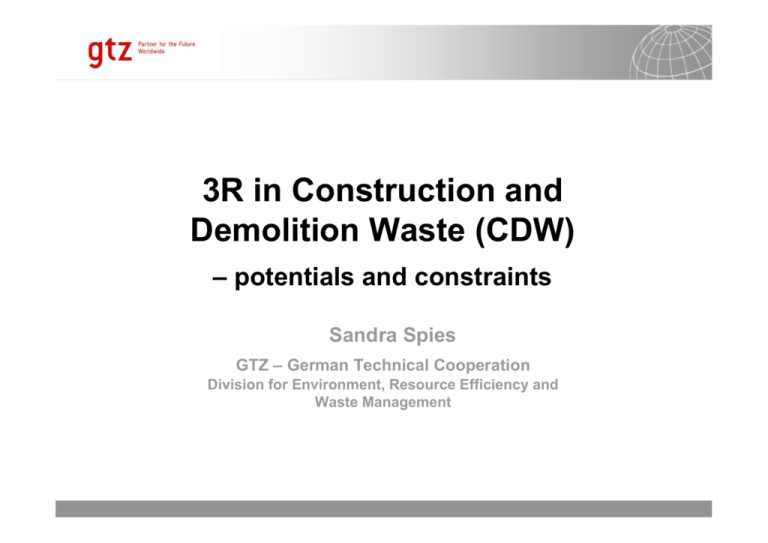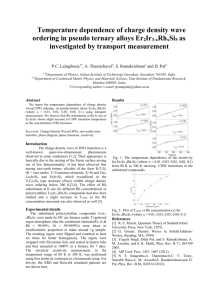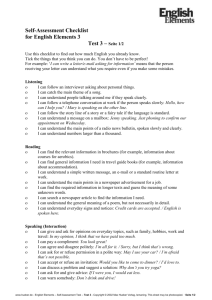3R-Construction-Demolition
advertisement

3R in Construction and Demolition Waste (CDW) – potentials and constraints Sandra Spies GTZ – German Technical Cooperation Division for Environment, Resource Efficiency and Waste Management 2009/11/30 Seite 1 Agenda Definition of Construction and Demolition Waste (CDW) Relationship between the 3R concept and CDW Situation in Germany Examples in Asia Indonesia Thailand India Possible applications Conclusion 2009/11/30 2009/11/30 Seite 2 Page Construction and Demolition Waste Construction waste: mainly leftovers from new construction materials (e.g. cut-offs, damaged materials), packaging waste, used materials during construction and all other wastes typical for activities on a construction site. Construction waste Demolition waste: collection of all construction materials from a building, after removal of certain (hazardous) parts (e.g. asbestos, mercury containing parts, tar, PVC). DW is much larger in volume than CW. Demolition waste 2009/11/30 2009/11/30 Seite 3 Page Facts around CDW Concrete is the second most consumed material after water and is the basis for the urban environment Consumption worldwide: 1950: less than 2 to 2.5 billion tonnes 2006: between 21 and 31 billion tonnes CDW can constitute up to 50% of the MSW In many industrialized countries reuse and recycling of CDW is an integrated part of their SWM schemes and achieve recycling quotas of up to 90 % and more Countries such as the Netherlands and Japan achieve near complete recovery of waste concrete CDW Recycling technology 2009/11/30 2009/11/30 Seite 4 Page Negative Impacts of CDW (1) Source: Fimpel Consult 2009/11/30 Page Seite 5 2009/11/30 Negative Impacts of CDW (2) Bangkok, Thailand Italy Louisiana, USA San José, Costa Rica 2009/11/30 2009/11/30 Seite 6 Page Solutions for CDW according to 3R e.g. multi-purpose buildings, reusable building structure, prefabricated buildings g sin re a Inc e.g. Reuse door frames, pipes, windows, etc. it bil ina sta su e.g. Aggregate steel, wood y e.g. Incineration with/without energy recovery, garbage dump, sanitary landfill 2009/11/30 2009/11/30 Seite 7 Page Sorted wood for recycling Demolition material CDW landfills Reusing doors and frames Predesigned Recycled aggregate and prefabricated houses 2009/11/30 2009/11/30 Seite 8 Page Close-loop solution for CDW Reduce Reuse Recycle Dispose Natural resources Production of primary building material Production of secondary building material Construction of new buildings and structures Non recyclable CDW Controlled disposal Recyclable CDW CDW recycling outside of construction industry Emissions to the environment CDW treatment Selective demolition Use of buildings and structures 2009/11/30 Seite 9 Page Economic advantages Economic impulses Æ Improvement of the income situation of the recycling industry More jobs for workers with low and high qualification levels Recovery of costs associated with transportation and tipping fees Good quality of waste materials stimulated by better prices Reduction of disposal costs Æ Less wastes end up in landfills, increasing lifetime and reducing costs Conservation of natural resources Æ Return of waste materials into the materials’ cycle Reduction of the dependency on primary materials Lower costs of new constructions Æ Lower prices than new materials CDW Recycling 2009/11/30 2009/11/30 Seite 10 Page Environmental advantages Natural resources Æ Less primary resources, smaller raw materials warehouse, lower landscape consumption Reduction of CO2-Emissions Æ Less production energy when recycling Smaller transport distances Elimination of illegal and unauthorised dumping Æ Recycling discourages illegal dumping and reduces negative environmental effects upon groundwater, surface-water, air, flora & fauna and landscape Improvement of air quality Æ Controlled disposal of non-mineral CDW means to be able to prevent ignition and incineration of e.g. rubber and plastic 2009/11/30 2009/11/30 Seite 11 Page Social and health advantages Reduction of health hazards generated by illegal deposits Æ Reduction of proliferation of pests if CDW is deposited on controlled sites Emissions into the air or leaching of toxic substances into the soil and/or groundwater affect the population Unstable dumps and deposits are dangerous for civilians and workers Reduction of health hazards generated by incineration Æ Uncontrolled incineration of CDW can cause emissions of toxic compounds or substances such as dioxins Better use of public space Æ Lower growth rate of landfills and more space for productive uses, e.g. green or living areas CDW Recycling 2009/11/30 2009/11/30 Seite 12 Page Instruments Life Cycle Analysis (LCA) Æ consider each state of the product’s life environmental criteria: resource use, embodied energy, embodied pollution, recyclability, material efficiency, product life Green Paper on Integrated Product Policy (IPP) Æ Producer Responsibility Design and planning Æ considerations around new projects resource saving, flexibility for future changes, durable and non-toxic products, recycled products, labelling of products, no overestimation of quantities, planning future deconstruction Tendering Æ clarify major requirements before beginning projects certified contractors, minimize waste, management plans, payment on fulfilment During and after construction Æ waste minimization organized site, supply just in time and with minimum packaging, separation of materials, appropriate disposal During renovation and deconstruction Æ waste minimization licensed contractors, renovation or deconstruction plan, separation of wastes, controlled deconstruction 2009/11/30 2009/11/30 Seite 13 Page Prerequisites Research and development Æ universities, research institutes and private companies Legislation and enforcement Æ legal framework, licensing, sanctions and fees Economic incentives to support the market Æ high landfill taxes, taxes for quarrying, import duties for raw materials, etc. Establishment of professional associations Æ representation of members and industry in legislative venues; facilitation of interaction between members and organizations; provide information Certification Æ quality assurance Information exchange Æ workshops, seminars, training programmes to achieve progress Promotion of CDW reuse and recycling Æ gain general acceptance, e.g. campaigns, green procurement mandatory for government and communal buildings 2009/11/30 2009/11/30 Seite 14 Page Situation in Germany CDW recycling was introduced beginning the 1980s Generation (2007): 201.8 Mio.tons (57% of the total generated wastes) 64 % soil from excavation, 25% mineral CDW, 8 % from road rehabilitation; 3 % construction waste Recycling rate (2007): 89.2 % Extensive legislation and administrative directives on reuse and recycling of CDW; e.g.: source separation at construction and selective demolition are compulsory Extensive monitoring system on quality and quantities self-commitment on achieving high recycling rates Decreasing CDW intensity (kg CDW / GDP) CDW Container 2009/11/30 2009/11/30 Seite 15 Page Waldspiral building in Darmstadt Separation during demolitionReusing Berlin Wall in a recycling plant Garden and Landscape architecture in Munich 2009/11/30 2009/11/30 Seite 16 Page Examples in Asia (1) Indonesia Treatment, reuse, recycle of debris waste generated by the Indian Ocean Tsunami (around 854 000 m3) Common CDW 9 Partnerships with the Ministry of Environment, local government agencies, civil society organizations, technology suppliers and other agencies 9 DEBRI-Project (UNEP) with three key pillars: 9 (a) technology support 9 (b) capacity building 9 (c) economic instruments Reparation of window frames and doors 2009/11/30 2009/11/30 Seite 17 Page Examples in Asia (2) Thailand 9 9 9 No legislation on CDW management No CDW recycling facility or CDW-disposal site in Bangkok Debris wastes from the tsunami were disposed in landfills Reusable items are removed and marketed by private companies 2007: Baseline study on quantities of CDW produced in Bangkok 2009: Estimation of CW generation and management in Thailand Joint project between Ministry of Environment and GTZ with recommendations on CDW management 9 The Bangkok Metropolitan Administration plans CDW processing facilities and introduction of collection, transportation and disposal fees Construction activities after the tsunami 2009/11/30 2009/11/30 Seite 18 Page Examples in Asia (3) India Manual on MSW Management includes a chapter on CDW but states that CDW is not reused or recycled in India TIFAC reports that some demolition contractors have recovery rates from 25% in old buildings to 75% in new buildings, but that these activities are not widely practiced 9 18th November 2008: Constitution of Working Group on MSW, Plastic, Demolition and Packaging Waste with a Working Sub-Group on construction and demolition waste 16th April 9 Regular meetings: Nov. 2008, Jan. 2009, Apr. 2009 Construction activities after the tsunami 2009/11/30 2009/11/30 Seite 19 Page Possible applications Information exchange Æ good practices of other countries Awareness campaigns Research and development technologies Æ waste mapping, standards Institutional and legal basis Æ consider participation of the industrial branch Required infrastructure Æ consider privatisation Strengthening the market Æ taxes on landfilling, importing raw material and quarrying virgin material, tax exemptions for recycled materials Traditional construction with recycled materials 2009/11/30 2009/11/30 Seite 20 Page Conclusion Reduction of energy consumption as well as of CO2-Emissions Production energy of recycled materials is considerably less than the energy used to produce and transport primary construction materials. Reduction of environmental degradation Illegal dumping of waste and excessive extraction of natural resources has negative environmental effects. Reduction of health hazards generated by illegal deposits Proliferation of pests can be reduced if CDW is reduced, reused, recycled and minimal quantities are deposited on controlled landfills Improvement of air quality Emissions due to production and uncontrolled disposal or burning are reduced. 2009/11/30 2009/11/30 Seite 21 Page Thanks for your attention! Sandra Spies sandra.spies@gtz.de www.gtz.de/solid-waste-management 2009/11/30 2009/11/30 Seite 22 Page









